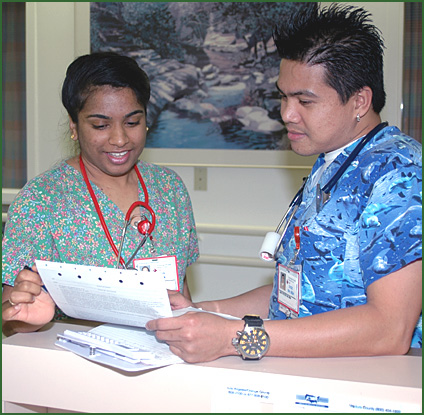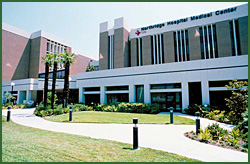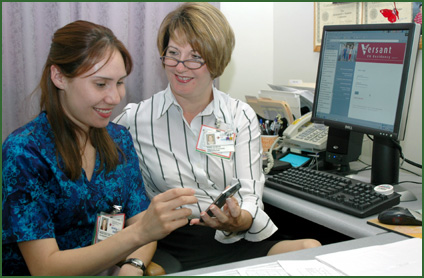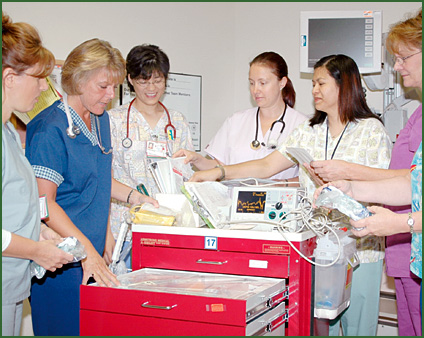RN Residency: Seeking a New Paradigm
March / April 2007
RN Residency: Seeking a New Paradigm

![]()
Few, if any, hospitals have been able to sidestep the many challenges arising from the continued shortage of qualified nurses across the United States. From the large sign-on bonuses many hospitals opt to pay new nurse hires, to the constant use of temporary and registry nurses to balance shifts, the shortage has had a daunting impact on the financial health of the institutions.
However, the most important consideration stemming from the crisis in nurse staffing lies in the quality of care that we deliver to patients and, in turn, the level of patient safety that hospitals strive to attain. One need only look at the University of Pennsylvania’s 2002 (Aiken, et al.) study results, which confirm that larger patient-to-RN ratios are directly linked to a greater risk of complications after surgery, to understand the magnitude of this challenge.
One of the key drivers for the rapid turnover that contributes to the nursing shortage is the “preparedness gap.” While hospitals aim to address patient safety by ensuring there are sufficient RNs for every shift, the reality is that new graduate RNs may not be sufficiently prepared to assume the complex RN role in acute care.
For instance, many nurse training programs have limited clinical immersion components. As a result, new graduate RNs receive fewer opportunities to learn the skills, techniques, protocols, and best practices of their hospital. Compounding the lack of hands-on practical experience is the fact that fewer new nurse graduates have the opportunity to work shoulder-to-shoulder with veteran nurses. It’s hardly a surprise that U.S. hospitals lose anywhere between 35 to 60 percent of their new nurse workforce within 12 to 24 months (Jones, 2004).
Unlike graduate medical education, which is partially funded through Medicare and standardized according to different disciplines under the purview of the Accreditation Council for Graduate Medical Education, there are no structured nursing residency programs with nationally accepted standards. Comprehensive residencies are not yet required. Furthermore, there is no overarching organization to ensure that quality standards are met. Consequently, there is tremendous variance across hospitals nationwide. As such, there is little guarantee that the homegrown residencies, internships, or in-house orientation programs adequately prepare new graduate nurses to deliver adequate patient care and clinical services.
More than ever before, our profession needs comprehensive, structured training and focused retention efforts to increase the confidence and competence of nursing graduates, reduce churn, lower costs, and, most important, ensure higher levels of patient safety.
Evidence-Based Training Driven by Consistent Clinical Standards
 |
|
Northridge Hospital Medical Center in Northridge, Calif., is a 411-bed facility that boasts some of the most technologically advanced and compassionate services — from the Neuroscience Institute, Level II Trauma Center, and heliport, to cancer care and a Women’s Health Center. Yet, even with its commitment to delivering quality care, not even Northridge was immune to the burdens arising from inadequate RN staffing.
Accordingly, Northridge assembled a modest training program of 6 to 8 weeks for medical/surgical nurses (somewhat longer for certain other specialties) that consisted of classroom activity and preceptorship on the nursing units. However, as valuable as these previous efforts were, they did fall short of the larger emerging goal: ensuring a higher level of confidence and competency through carefully tracked, evidence-based training and consistent clinical standards and practices.
In 2004, Northridge embarked on an ambitious initiative to transform its nurse training program by implementing the Versant RN Residency. The residency, an evidence-based, outcome-driven, comprehensive 18-to-22-week program, encompasses more than 600 hours of precepted clinical time and 200 hours of classes. The residency also features mentorship and peer-support components. All participating new nurse hires at Northridge maintained their full-time paid employee status throughout the duration of the residency.
The Versant RN Residency provided Northridge’s nurse executives and clinical managers with the tools they needed to implement a standardized core curriculum for new nurse hires. Additionally, the residency afforded the medical center the opportunity to enhance the standardized curriculum with customized practices, methods, and procedures that reflect how the hospital works. This centralized, standardized approach has resulted in better new graduate nurses, as confirmed by the chief nurse executive, charge nurses, nursing directors/managers and attending physicians.

![]()
Eliminating the Preparedness Gap
In February 2005, Northridge’s first full-scale nursing residency cohort — a group of nine nurses — began their 20-week program. In addition to almost daily assessments on hundreds of tasks and skills, the cohort underwent evaluations at the beginning, middle, and end of the residency (as well as a year later). This included 13 different evaluation tools (including 76 direct observations of competency evaluations) to assess skills, physical interactions, communication, and more. Northridge also examined many less tangible metrics, from decision-making, group cohesion, and leader empowerment to nurse satisfaction, self-confidence, turnover intention, and more.
Previously, Northridge’s less-structured nurse-training initiatives relied on paper-based tracking, which made it difficult to assess whether the new nurse hire had successfully completed a particular task, for instance. With the deployment of the Versant RN Residency, however, Northridge used a Web portal, Versant VoyagerTM. Designed to eliminate the cumbersome, paper-based processes affiliated with training, Voyager offers a fully hosted suite of applications designed to deliver the curriculum and track clinical performance. Preceptors go online to update the specific milestones a nurse resident has achieved. Nurse managers can go online and instantly see where each nurse stands in meeting his/her competency goals and residents can also track their own process.

![]()
Improving Patient Safety
By using standardized core clinical competencies, Northridge significantly reduced the variation in clinical practices, which is a critical step toward improved patient safety. What’s more, the preceptor teaches skills, shares knowledge, and helps prevent medical errors by teaching critical thinking at the bedside. New nurse hires are taught to keep three important factors in mind as part of their daily scope of clinical responsibilities: What’s the problem? What should I do? How fast do I need to act?
By increasing competency, self-confidence, and critical thinking, the nursing residency fosters an increased awareness of and attention to patient safety. In fact, graduates from the first Northridge cohort scored equal to or higher than a control group from the previous home-grown nurse-training program. Greater staffing stability has also reduced the hospital’s reliance on temporary and traveling nurses, which has created more consistent patient care and greater patient safety.
Improving Recruitment and Retention
Since the inception of its residency program, Northridge has reduced its turnover rate by approximately 25 percent, and anticipates that future residency cohorts will experience an even greater decrease in turnover rate due to improvements made in the program since 2004. Most recently, the hospital completed its fourth residency cohort, consisting of 19 nurse residents. The residency has had a significant effect on candidate recruitment as well. Northridge is now in a position to be more selective with candidates, as it offers new recruits a unique educational opportunity to bolster their clinical competence and confidence, while enhancing their leadership skills.
This culture of retention has also extended to senior staff at the hospital. As they begin to see the consistency and value that the residency provides, Northridge senior nurses are now volunteering to be preceptors and mentors and to refine the curriculum and standards even further. What’s more, some members of the first nursing residency cohort have begun to act as preceptors, helping to extend the learning culture of the hospital.
Financially, the residency has yielded significant savings for the hospital. With the cost to train a nurse reaching an average of $50,000, Northridge believes it has saved several hundred thousand dollars in recruitment and retention alone.
Ultimately, the Versant RN Residency has helped Northridge Hospital Medical Center institute standard clinical practices, deliver comprehensive and structured training, improve the quality of its nursing care (through competency and confidence), increase patient safety, and reduce turnover and use of registry/temporary nurses, and significantly lower its recruitment, retention, and staffing costs.
Judy Sumner is program manager for R.N. Residency at Northridge Hospital Medical Center, California. She received her B.S.N. and P.H.N. from Mount St. Mary’s College in Los Angeles, California. She is an Alumnus CCRN, having maintained the American Association of Critical-Care Nurses CCRN certification for 26 years. Sumner has had extensive experience during 35 years in nursing, including critical care and medical surgical arenas, nursing supervision and management, and education. She has been an invited guest speaker and presenter at national Versant User Conferences and an international conference, Workplace Integration of New Nurses (WINN), regarding the RN Residency program. Sumner has received a number of professional and volunteer service awards, including the DAISY Award for Extraordinary Nurses. Summer may be contacted at judith.sumner@chw.edu.
Patricia Cornett is senior vice president for evaluation, curriculum and new product development at Versant. She, too, has more than 35 years of diverse healthcare experience, including clinical resource management, new product development, clinical process redesign, as well as organization and staff development. Cornett oversees the research component of the residency, analyzes and interprets research data for client facilities, leads new product development initiatives for the organization’s pipeline workforce management programs and oversees the Versant RN Residency pediatric and adult core curricula. For the past four years, Cornett has served as a co-investigator of “The Acute Care Nursing Unit — a Healthy Workplace,” which establishes a framework for healthy emergency department workplaces. Cornett earned her Ed.D. from Rutgers University, a B.S. in nursing from University of Colorado, and a M.S. in nursing from Texas Woman’s University as a clinical nurse specialist focusing on adult respiratory care. She may be contacted at pcornett@chla.usc.edu.
References
Aiken, L. H., Clarke, S. P., Sloane, D. M., Sochalski, J., & Silber, J. H. (2002). Hospital nurse staffing and patient mortality, nurse burnout, and job dissatisfaction. Journal of Applied Nursing Research, 286(16), 1987-1993.
Jones, C.B. (2004, December). The costs of nurse turnover: An economic perspective, JONA (Journal of Nursing Administration).
